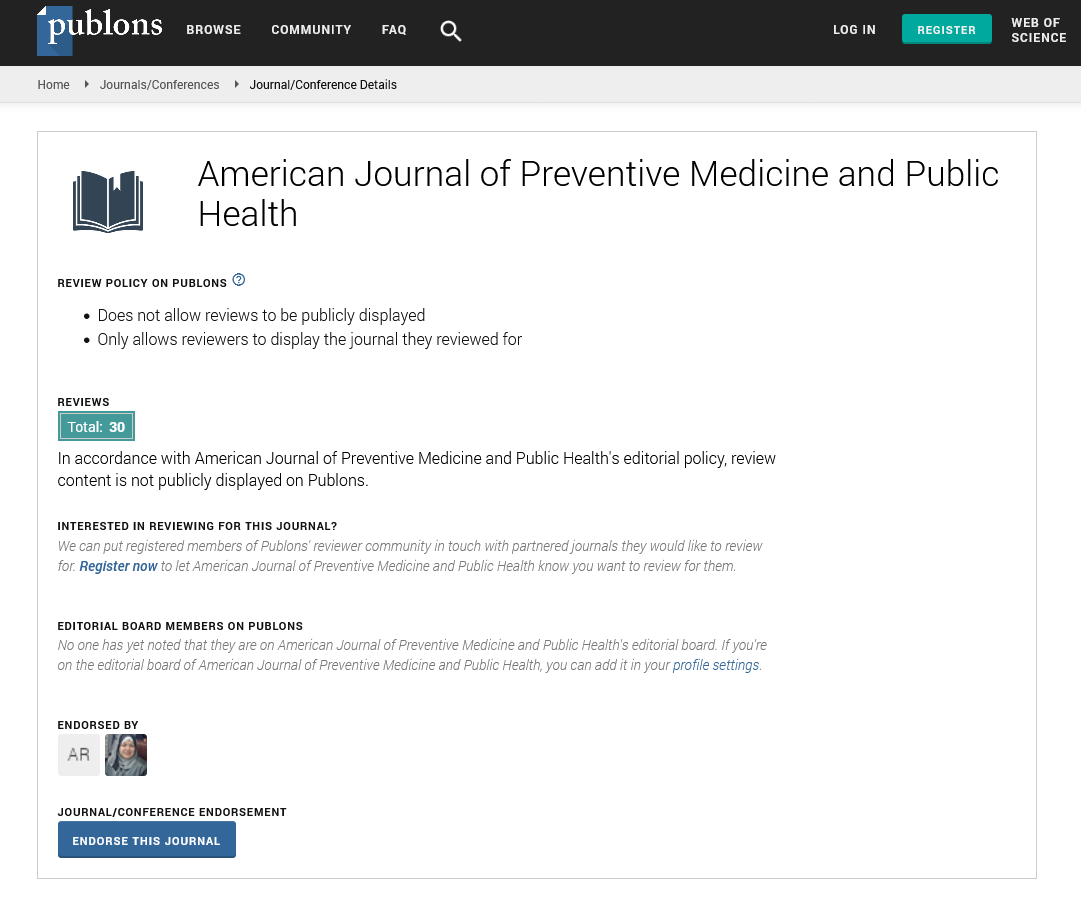Commentary - American Journal of Preventive Medicine and Public Health (2022)
Risk Factors and Outcomes Associated with Chronic Hepatitis D Virus
Jennifer Thomas*Jennifer Thomas, Department of Internal Medicine, University of Texas Medical Branch, Galveston, USA, Email: thomasjenny12@gmail.com
Received: 30-Sep-2022, Manuscript No. AJPMPH-22-79265; Editor assigned: 03-Oct-2022, Pre QC No. AJPMPH-22-79265 (PQ); Reviewed: 17-Oct-2022, QC No. AJPMPH-22-79265; Revised: 24-Oct-2022, Manuscript No. AJPMPH-22-79265 (R); Published: 31-Oct-2022
Description
The most serious type of viral hepatitis, Chronic Hepatitis Delta (CHD), is caused by the Hepatitis Delta Virus (HDV). To stop the virus’s relentless path from developing cirrhosis, end-stage liver disease, and hepatocellular carcinoma, effective antiviral medicines are urgently needed. Hepatitis B virus (HBV) and HDV infections can happen simultaneously or as a super infection in those who already have HBV infections that are persistent. The only reason HDV is dependent on HBV is that it has evolved to use the HBV-encoded envelope proteins for infection and release. Since HBV envelope proteins can originate from chromosomally integrated sequences as well as from HBV genomes found in cell nuclei Covalently {Closed Circular DNA (cccDNA) minichromosomes}, both sources may be involved in HDV release.
The HDV genome is a 1.7 kb circular, negative-sense, single-stranded RNA that has paired nucleotides and forms an unbranched rod-like shape. Using the host RNA polymerase II and double rolling-circle amplification process, HDV replicates in the nucleus after entering the hepatocytes through the sodium taurocholate co-transporting polypeptide (NTCP). This results in the accumulation of 2 additional RNAs: the antigenomic HDV RNA and a smaller mRNA coding for the 2 isoforms of the hepatitis delta antigen. Genomes and AG-HDV RNAs connect with HDAg proteins during replication, and host Adenosine Deaminase Acting on RNA (ADAR) edits AG-HDV RNA to create a mutation in the S-HDAg stop codon that allows creation of the L-HDAg. The cellular farnesyl transferase prenylates L-HDAg, which encourages the endoplasmic reticulum to acquire HBV envelope proteins, leading to the release of the virus.
At least 12 million people globally have HBV/HDV coinfection, but the actual figure may be higher due to inadequate testing, especially in regions with high prevalence. There are 8 genotypes of HDV. The HDV genotypes 1 and 3 show the highest disparities in terms of sequence divergence, which can reach 40%.
There aren’t many treatment options available for HDV because of its unusual replication mechanisms. Despite the side effects, limited response rates, and high relapse rates, pegylated interferon alpha (pegIFN) has been used as an off-label treatment for HDV for decades. The first HDV-specific medication to receive conditional marketing permission in Europe is bulevirtide, which effectively prevents HBV and HDV entry by targeting NTCP. This is one of the new anti-HDV techniques. The farnesyl transferase is inhibited by lonafarnib, which is being evaluated in clinical studies and preventing the production of HDV. Nucleic acid polymers prevent the release of HDV and HBsAg, albeit their exact route of action is still being studied. PegIFN-based treatments are being evaluated in clinical trials as well. IFNs’ MoA in HDV infection is yet unknown and investigations employing several isolates suggested that IFN-responsiveness may vary greatly between strains.
High volumes of HBsAg+subviral particles are released along with HBV and HDV particles when HBV and HDV replication levels are high, such as in acute HBV/HDV coinfection, highly viremic CHD patients, or in humanised mice. HBV envelope proteins arise mostly from HBV cccDNA. The percentage of infected cells is large in this instance, and the NTCP receptor is mostly used for viral release and new infection events. However, as CHD progresses naturally, persistent inflammation that results in cell death and compensatory cell turnover can significantly lower intrahepatic HBV cccDNA burdens, resulting in cells that are still carrying HBV DNA integrations but have cleared the cccDNA, with the potential to produce HBV envelope proteins.
Therefore, it is conceivable that as time passes, inflammatory events will hasten intrahepatic HDV spread among daughter cells while decreasing intrahepatic cccDNA levels. This heterogeneous infection landscape may change, especially in an environment with few de novo infection events, as is frequently seen in patients with HBeAg-negative CHD and those on nucleotide analogues to reduce HBV viremia. Increased levels of cytokines may also promote the growth of cells with HBV DNA integrations and/or HDV while reducing viremia and NTCP-mediated HBV and HDV infection events. Since HDV can survive in the hepatocytes without HBV, an HBV infection can convert a latent HDV-monoinfection into a productive coinfection. As a result, prevention of future infection episodes may be crucial to therapeutic approaches for treating CHD.
Copyright: © 2022 The Authors. This is an open access article under the terms of the Creative Commons Attribution NonCommercial ShareAlike 4.0 (https://creativecommons.org/licenses/by-nc-sa/4.0/). This is an open access article distributed under the terms of the Creative Commons Attribution License, which permits unrestricted use, distribution, and reproduction in any medium, provided the original work is properly cited.







